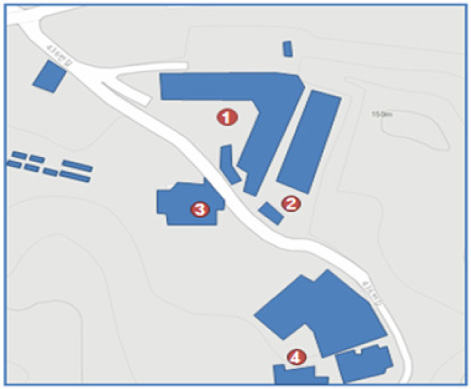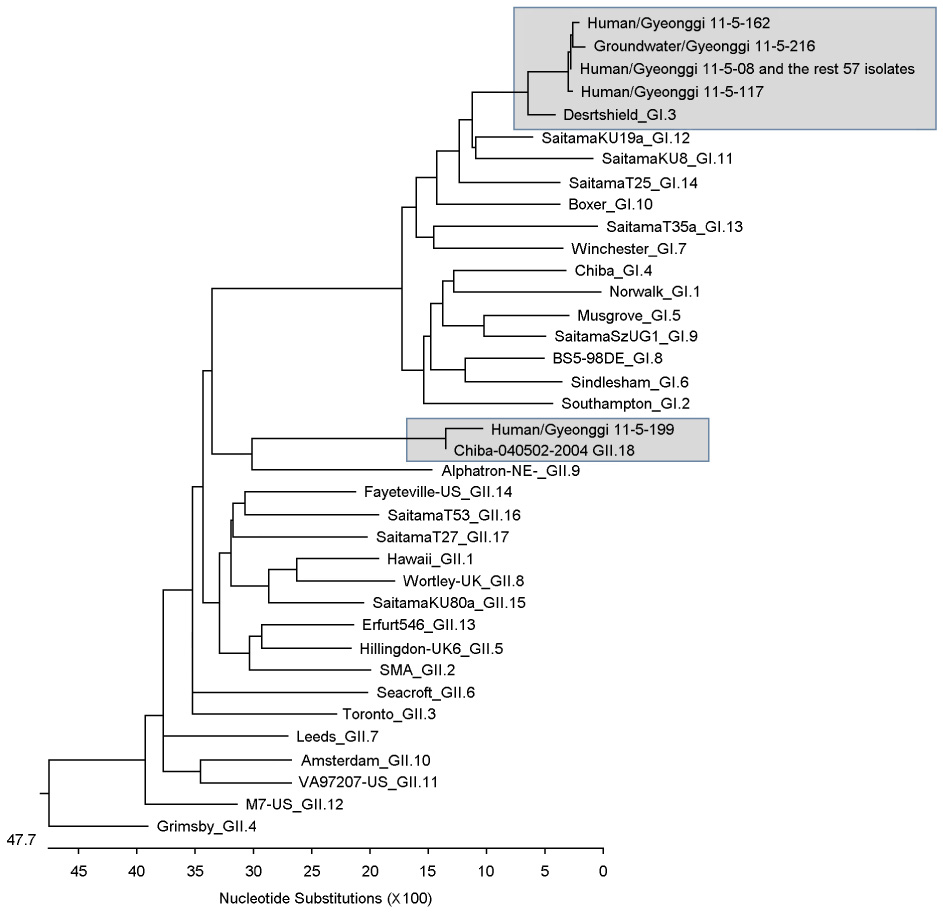J Bacteriol Virol.
2012 Sep;42(3):232-241. 10.4167/jbv.2012.42.3.232.
Epidemiological Study of Ground-waterborne Norovirus GI.3-associated Gastroenteritis Outbreaks in Gyeonggi Province of South Korea in May 2011
- Affiliations
-
- 1Gyeonggi-do Institute of Health & Environment 95, Pajangcheon st, Jangan-gu, Suwon-city, Gyeonggi-do, Korea.
- 2Department of Biology, Kyonggi University Graduate School 94-6, Iui-dong Yeongtong-gu, Suwon-city, Gyeonggi-do, Korea. lmjin@gg.go.kr
- KMID: 1434752
- DOI: http://doi.org/10.4167/jbv.2012.42.3.232
Abstract
- In May 2011, five consecutive gastroenteritis outbreaks were reported at schools in Gyeonggi-do. Epidemiological inspection revealed that one food manufacture company provided 'Kimchi', a traditional Korean side-dish, to these five schools for catering services. Fecal specimens were collected from students and food-handlers to determine causative viral agents. Norovirus genogroup GI was detected from 58 samples out of total 239 specimens by reverse-transcription (RT)-PCR, whereas norovirus GII was found only from one sample. Epidemiological studies also revealed that the Kimchi was processed using groundwater in the food manufacture company. Four groundwater samples were collected from the company and around the area. Norovirus GI was detected from three samples. To determine the norovirus genotypes of positive specimens from clinical and groundwater samples, sequencing and phylogenetic analyses were performed. The genogroup GI from 58 clinical and three groundwater samples and the GII from one food-handler were identified as norovirus GI.3 and GII.18, respectively. Sequence alignment analysis with norovirus GI.3 isolates revealed that identity between clinical and groundwater samples was over than 99.1% in nucleotide level. In conclusion, norovirus GI.3-contaminated groundwater caused the gastroenteritis outbreaks of five schools, through Kimchi. This molecular epidemiological study was an important report in Korea that clearly identified all transmission routes of norovirus GI.3.
Keyword
MeSH Terms
Figure
Reference
-
1. Chikhi-Brachet R, Bon F, Toubiana L, Pothier P, Nicolas JC, Flahault A, et al. Virus diversity in a winter epidemic of acute diarrhea in France. J Clin Microbiol. 2002. 40:4266–4272.
Article2. Fankhauser RL, Monroe SS, Noel JS, Humphrey CD, Bresee JS, Parashar UD, et al. Epidemiologic and molecular trends of "Norwalk-like viruses" associated with outbreaks of gastroenteritis in the United States. J Infect Dis. 2002. 186:1–7.
Article3. Kim SH, Cheon DS, Kim JH, Lee DH, Jheong WH, Heo YJ, et al. Outbreaks of gastroenteritis that occurred during school excursions in Korea were associated with several waterborne strains of norovirus. J Clin Microbiol. 2005. 43:4836–4839.
Article4. Lee SG, Jheong WH, Suh CI, Kim SH, Lee JB, Jeong YS, et al. Nationwide groundwater surveillance of noroviruses in South Korea, 2008. Appl Environ Microbiol. 2011. 77:1466–1474.
Article5. Bon F, Ambert-Balay K, Giraudon H, Kaplon J, Le Guyader S, Pommepuy M, et al. Molecular epidemiology of caliciviruses detected in sporadic and outbreak cases of gastroenteritis in France from December 1998 to February 2004. J Clin Microbiol. 2005. 43:4659–4664.
Article6. Maunula L, Miettinen IT, von Bonsdorff CH. Norovirus outbreaks from drinking water. Emerg Infect Dis. 2005. 11:1716–1721.
Article7. Noda M, Fukuda S, Nishio O. Statistical analysis of attack rate in norovirus foodborne outbreaks. Int J Food Microbiol. 2008. 122:216–220.
Article8. de Wit MA, Koopmans MP, Kortbeek LM, Wannet WJ, Vinjé J, van Leusden F, et al. Sensor, a population-based cohort study on gastroenteritis in the Netherlands: incidence and etiology. Am J Epidemiol. 2001. 154:666–674.
Article9. Kaplan JE, Gary GW, Baron RC, Singh N, Schonberger LB, Feldman R, et al. Epidemiology of Norwalk gastroenteritis and the role of Norwalk virus in outbreaks of acute nonbacterial gastroenteritis. Ann Intern Med. 1982. 96:756–761.
Article10. Jiang X, Wang M, Wang K, Estes MK. Sequence and genomic organization of Norwalk virus. Virology. 1993. 195:51–61.
Article11. Lambden PR, Caul EO, Ashley CR, Clarke IN. Sequence and genome organization of a human small round-structured (Norwalk-like) virus. Science. 1993. 259:516–519.
Article12. Maguire AJ, Green J, Brown DW, Desselberger U, Gray JJ. Molecular Epidemiology of Outbreaks of Gastroenteritis Associated with Small Round-Structured Viruses in East Anglia, United Kingdom, During the 1996-1997 Season. J Clin Microbiol. 1999. 37:81–89.
Article13. Belliot G, Noel JS, Li JF, Seto Y, Humphrey CD, Ando T, et al. Characterization of capsid genes, expressed in the baculovirus system, of three new genetically distinct strains of "Norwalk-Like Viruses". J Clin Microbiol. 2001. 39:4288–4295.
Article14. Green SM, Dingle KE, Lambdeb PR, Caul EO, Ashley CR, Clarke IN. Human enteric Caliciviridae: a new prevalent small round-structured virus group defined by RNA-dependent RNA polymerase and capsid diversity. J Gen Virol. 1994. 75:1883–1888.
Article15. Ando T, Mulders MN, Lewis DC, Estes MK, Monroe SS, Glass RI. Comparison of the polymerase reagion of small round structured virus strains previously classified in three antigenic types by solid-phase immune electron microscopy. Arch virol. 1994. 135:217–226.
Article16. Okada M, Ogawa T, Kaiho I, Shinozaki K. Genetic analysis of noroviruses in Chiba Prefecture, Japan, between 1999 and 2004. J Clin Microbiol. 2005. 43:4391–4401.
Article17. Park KS, Jeong HS, Baek KA, Lee CG, Park SM, Park JS, et al. Genetic analysis of norovirus GII.4 variants circulating in Korea in 2008. Arch Virol. 2010. 155:635–641.
Article18. Lee H, Kim M, Lee JE, Lim M, Kim M, Kim JM, et al. Investigation of norovirus occurrence in groundwater in metropolitan Seoul, Korea. Sci Total Environ. 2011. 409:2078–2084.
Article19. Gallay A, De Valk H, Cournot M, Ladeuil B, Hemery C, Castor C, et al. A large multi-pathogen waterborne community outbreak linked to faecal contamination of a groundwater system, France, 2000. Clin Microbiol Infect. 2006. 12:561–570.
Article20. Lee C, Kim SJ. The genetic diversity of human noroviruses detected in river water in Korea. Water Res. 2008. 42:4477–4484.
Article21. Kojima S, Kageyama T, Fukushi S, Hoshino FB, Shinohara M, Uchida K, et al. Genogroup-specific PCR primers for detection of norwalk-like viruses. J Virol Methods. 2002. 100:107–114.
Article22. Lee SG, Lee SH, Park SW, Suh CI, Jheong WH, Oh S, et al. Standardized positive controls for detection of norovirus by reverse transcription PCR. Virol J. 2011. 8:260.
Article23. Greenberg HB, Valdesuso J, Yolken RH, Gangarosa E, Gary W, Wyatt RG, et al. Role of Norwalk virus in outbreaks of nonbacterial gastroenteritis. J Infect Dis. 1979. 139:564–568.
Article24. Lopman B, Vennema H, Kohli E, Pothier P, Sanchez A, Negredo A, et al. Increase in viral gastroenteritis outbreaks in Europe and epidemic spread of new norovirus variant. Lancet. 2004. 363:682–688.
Article25. Noel JS, Fankhauser RL, Ando T, Monroe SS, Glass RI. Identification of a distinct common strain of "Norwalk-like viruses" having a global distribution. J Infect Dis. 1999. 179:1334–1344.
Article26. White PA, Hansman GS, Li A, Dable J, Isaacs M, Ferson M, et al. Norwalk-like virus 95/96-US strain is a major cause of gastroenteritis outbreaks in Australia. J Med Virol. 2002. 68:113–118.
Article27. Huh JW, Kim WH, Moon SG, Lee JB, Lim YH. Viral etiology and incidence associated with acute gastroenteritis in a 5-year survey in Gyeonggi province, South Korea. J Clin Virol. 2009. 44:152–156.
Article28. Gallimore CI, Iturriza-Gomara M, Xerry J, Adigwe J, Gray JJ. Inter-seasonal diversity of norovirus genotypes: emergence and selection of virus variants. Arch Virol. 2007. 152:1295–1303.
Article29. Jung JH, Yoo CH, Koo ES, Kim HM, Na Y, Jheong WH, et al. Occurrence of norovirus and other enteric viruses in untreated groundwaters of Korea. J Water Health. 2011. 9:544–555.
Article30. Koh SJ, Cho HG, Kim BH, Choi BY. An outbreak of gastroenteritis caused by Norovirus-contaminated groundwater at a waterpark in Korea. J Korean Med Sci. 2011. 26:28–32.
Article31. Kukkula M, Arstila P, Klossner ML, Maunula L, Bonsdorff CH, Jaatinen P. Waterborne outbreak of viral gastroenteritis. Scand J Infect Dis. 1997. 29:415–418.
Article32. Rao VC, Metcalf TG, Melnick JL. Human viruses in sediments, sludges, and soils. Bull World Health Organ. 1986. 64:1–13.
Article
- Full Text Links
- Actions
-
Cited
- CITED
-
- Close
- Share
- Similar articles
-
- Human Norovirus Genogroups Detected from Acute Gastroenteritis Patients in Seoul from May 2013 to April 2015
- Occurrence of Norovirus GII.4 Sydney Variant-related Outbreaks in Korea
- Contributing Factors of Infectious Waterborne and Foodborne Outbreaks in Korea
- An Norovirus Outbreak at a Local Festival in Chungnam Korea
- Norovirus Infections in Asymptomatic Food Handlers in Elementary Schools without Norovirus Outbreaks in Some Regions of Incheon, Korea



